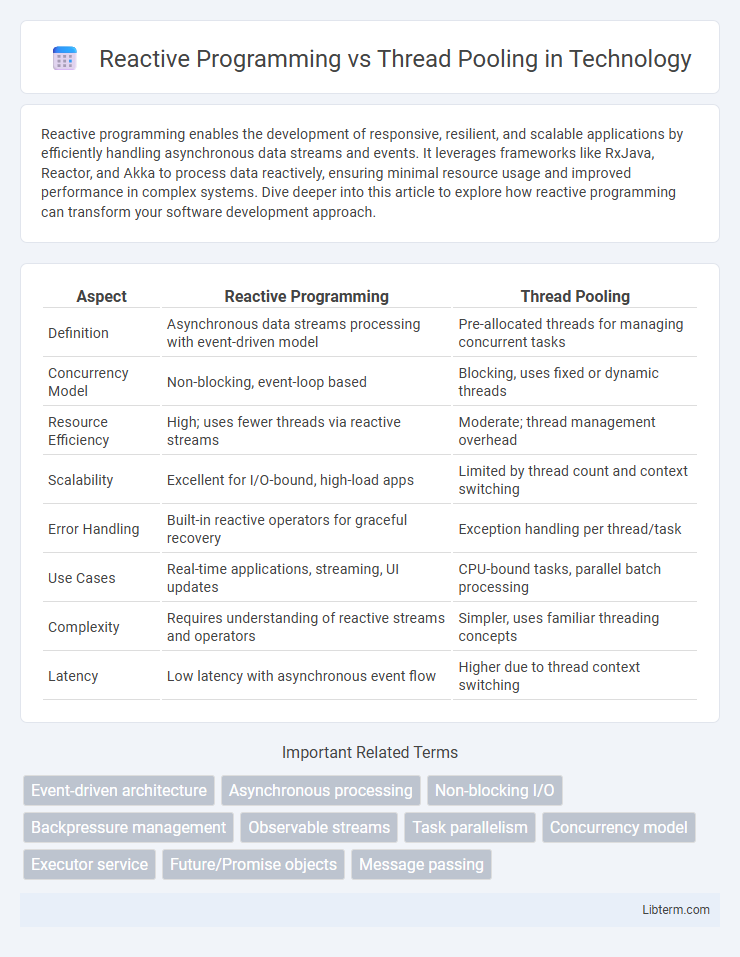Reactive programming enables the development of responsive, resilient, and scalable applications by efficiently handling asynchronous data streams and events. It leverages frameworks like RxJava, Reactor, and Akka to process data reactively, ensuring minimal resource usage and improved performance in complex systems. Dive deeper into this article to explore how reactive programming can transform your software development approach.
Table of Comparison
| Aspect | Reactive Programming | Thread Pooling |
|---|---|---|
| Definition | Asynchronous data streams processing with event-driven model | Pre-allocated threads for managing concurrent tasks |
| Concurrency Model | Non-blocking, event-loop based | Blocking, uses fixed or dynamic threads |
| Resource Efficiency | High; uses fewer threads via reactive streams | Moderate; thread management overhead |
| Scalability | Excellent for I/O-bound, high-load apps | Limited by thread count and context switching |
| Error Handling | Built-in reactive operators for graceful recovery | Exception handling per thread/task |
| Use Cases | Real-time applications, streaming, UI updates | CPU-bound tasks, parallel batch processing |
| Complexity | Requires understanding of reactive streams and operators | Simpler, uses familiar threading concepts |
| Latency | Low latency with asynchronous event flow | Higher due to thread context switching |
Introduction to Reactive Programming and Thread Pooling
Reactive programming is a programming paradigm centered around asynchronous data streams and the propagation of change, enabling efficient handling of real-time data and event-driven systems. Thread pooling manages a collection of reusable threads to execute multiple tasks concurrently, optimizing resource utilization and reducing the overhead of thread creation. Reactive programming simplifies handling complex asynchronous workflows, while thread pooling enhances performance and scalability in multithreaded applications.
Core Concepts: Understanding Reactive Programming
Reactive programming centers on asynchronous data streams and the propagation of change, enabling systems to handle events and data sequences without blocking threads. It uses observable sequences and operators to model dynamic data flows, promoting scalability and responsiveness in high-concurrency environments. This contrasts with thread pooling, which manages a fixed number of threads to execute tasks concurrently but may face limitations under high load due to thread contention and resource blocking.
Fundamentals of Thread Pooling Explained
Thread pooling optimizes concurrent processing by maintaining a pool of pre-instantiated threads ready to execute tasks, minimizing the overhead of thread creation and destruction. Each thread in the pool handles tasks sequentially, allowing efficient resource management and improved system responsiveness under heavy load. This contrasts with reactive programming, which emphasizes asynchronous, non-blocking event streams to handle operations more fluidly without relying on dedicated thread management.
Performance Comparison: Reactive vs Thread Pooling
Reactive programming enhances performance by efficiently managing I/O-bound tasks with non-blocking, event-driven models, reducing thread overhead and improving scalability. Thread pooling optimizes CPU-bound workloads by reusing fixed threads to handle concurrent tasks, minimizing thread creation costs but potentially leading to thread contention. Performance gains in reactive systems are prominent under high concurrency and I/O wait times, while thread pooling excels in predictable, CPU-intensive environments requiring controlled parallelism.
Scalability Considerations in Both Approaches
Reactive programming enhances scalability by enabling asynchronous, non-blocking operations that efficiently utilize system resources under high concurrency, reducing thread contention and context switching overhead. Thread pooling manages scalability by reusing a fixed number of threads to handle multiple tasks, balancing resource allocation but potentially facing bottlenecks when the demand exceeds pool capacity or tasks are blocking. Scalability in reactive systems generally outperforms thread pooling in high-load scenarios due to event-driven architecture and backpressure handling, which prevent resource exhaustion and improve throughput.
Resource Management: Efficiency and Overhead
Reactive programming enhances resource management by efficiently handling asynchronous data streams without dedicating threads to idle tasks, reducing overhead and maximizing CPU utilization. Thread pooling improves resource use by reusing a fixed number of threads to handle concurrent tasks, which decreases the cost of thread creation and context switching but can lead to resource contention under heavy load. Reactive systems typically offer better scalability and responsiveness in I/O-bound operations, while thread pooling remains effective for CPU-bound workloads requiring parallel execution.
Implementation Complexity and Learning Curve
Reactive Programming demands a deep understanding of asynchronous data streams, functional programming concepts, and event-driven architectures, making its implementation complexity significantly higher than Thread Pooling. Thread Pooling relies on managing a finite number of threads to execute tasks concurrently, offering a more straightforward approach but requiring careful management of thread lifecycle and resource allocation. The steep learning curve of Reactive Programming contrasts with the relatively simpler and more intuitive threading models, often leading teams to favor Thread Pooling in scenarios where ease of implementation outweighs scalability.
Use Cases Best Suited for Reactive Programming
Reactive programming excels in handling asynchronous, event-driven applications such as real-time data streaming, user interface updates, and IoT sensor data processing. It is best suited for scalable web services and microservices architectures where non-blocking I/O operations and backpressure management improve resource utilization and system responsiveness. High-concurrency environments, like chat applications or live financial trading platforms, benefit significantly from reactive programming's capacity to efficiently manage numerous simultaneous data flows.
Situations Where Thread Pooling Shines
Thread pooling excels in situations requiring predictable, consistent concurrency management with a limited number of threads handling blocking or CPU-bound tasks, such as database connection management or file I/O operations. It provides efficient resource utilization by reusing a fixed set of threads, minimizing overhead from thread creation and destruction in high-throughput server applications. Thread pooling is ideal when task execution time is relatively uniform and the workload involves synchronous, parallel processing.
Choosing Between Reactive Programming and Thread Pooling
Choosing between reactive programming and thread pooling depends on application requirements and workload characteristics. Reactive programming excels in handling high-concurrency, I/O-bound tasks with non-blocking asynchronous data streams, improving scalability and resource efficiency. Thread pooling is more suitable for CPU-bound tasks needing parallel execution with controlled thread counts, offering predictable performance and simplified resource management.
Reactive Programming Infographic

 libterm.com
libterm.com